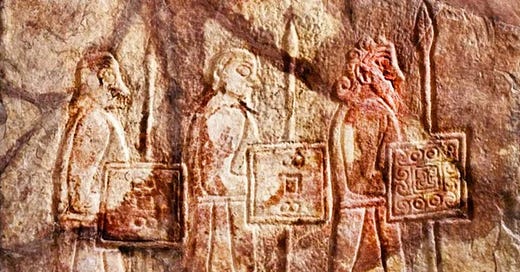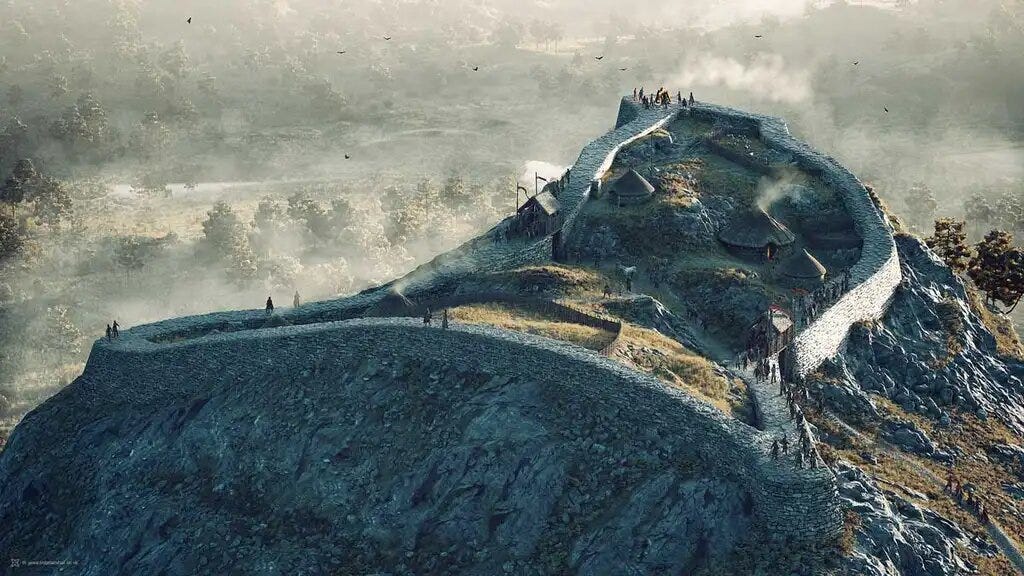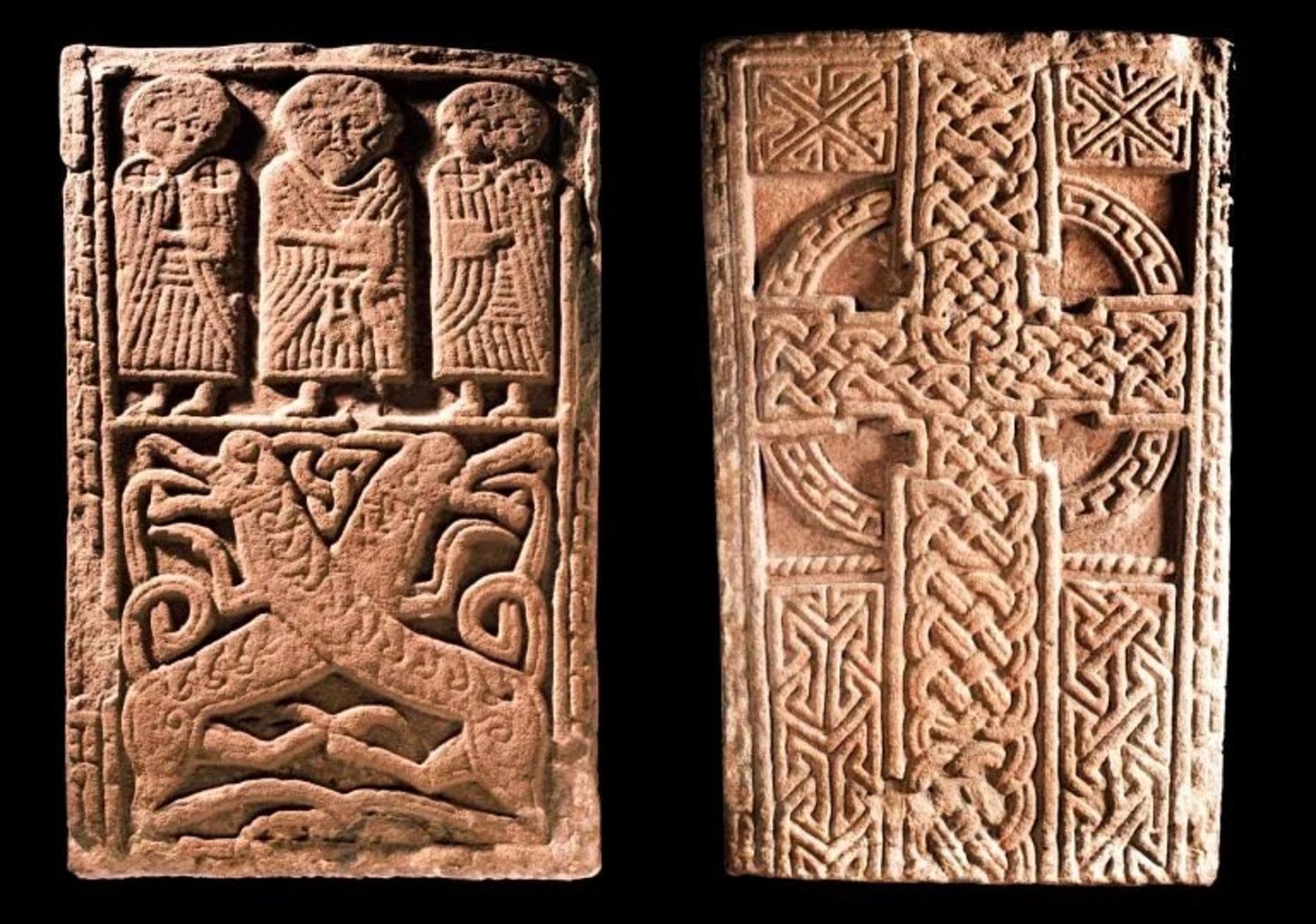The Origin of the Picts
Several medieval manuscripts contain an origin story for the Picts that traces their ancestry back to a pivotal figure known as Cruithne, their first King.
A portion of a Pictish stone slab showcasing three warriors with coiffed hair and shaped beards, from Birsay, Orkney, 7th or 8th century, National Museums Scotland
By the 4th century CE, the tribes living beyond the northern border of the Roman Province of Britannia were collectively referred to as the Picts. While Roman writers have shed some insight into these tribes and their culture, the Picts left little to no native writings, leaving much of their history, including their origin, to debate.
One legend of their origin is preserved in the Pictish Chronicles, a collection of medieval manuscripts based on oral legends. In the text, the first ruler of the Picts was a king known as Cruithne. A similar myth is preserved in the later Irish ‘Book of Lecan,’ written in the 14th century. It's interesting to point out that the word Cruithne could be Irish in origin. Prominent researchers such as Sir John Rhys and John T Koch have proposed that it is the Q-Celtic or Goidelic equivalent of the Brythonic word Prydin or Pretani. However, some still contested this.
An alternative source for the legend of King Cruithne is preserved in the 11th-century Lebor Bretnach. The latter is an early Middle Irish translation of Nennius’ early 9th-century work, Historia Brittonum, typically ascribed to the Irish poet Gilla Cóemáin. However, Lebor Bretnach isn’t a literal translation of Nennius’ work; it only summarises the Historia Brittonum, with the true focus of the manuscript being directed towards Gaelic matters.
A detached section of the Lebor Bretnach titled ‘Concerning Pictish Origins’ (Old Irish: Do Bunad Cruithnech) has garnered considerable interest over the past few centuries. In this section, we find a short poem dedicated to the ‘Mórseiser do Chruithne claind’ or the ‘Seven Children of Cruithne’. In this poem, the Picts trace their ancestry back to the legendary Cruithne, who divided the territory of Northern Scotland into seven districts for each of his seven sons. The verse is written in Old Irish and has four lines, each of seven syllables, grouped into two rhyming pairs. The quatrain (a complete poem of four lines) reads:
“Mórseiser do Cruithne claind
Raindset Albain i seacht raind
Cait Ce Círig cetach clann
Fíb Fidach Fotla Fortrenn.”
“Seven of Cruithne’s offspring
Divided Alba into seven shares
Cait, Ce, Círig, children with hundreds,
Fife, Fidach, Fotla, Fortriu.”
According to leading theories, the poem ‘Seven Children of Cruithne’ was added to ‘Concerning Pictish Origins’ during a period when the Pictish King’s list was extended forward to include the reign of Causantín, son of Cinaed, and backward to include the semi-mythical Cruithne and his sons. Causantin’s tenure as the Pictish king occurred between 862 and 876, suggesting the poem was added towards the end of the 9th century.
Interpretating The Seven Sons of Cruithne
Digital reconstruction of Dun da Lamh Pictish hillfort, by Bob Marshall, 2020, via Cairngorms National Park Authority
Scholars and historians have extensively discussed the quatrain over the past few centuries. Some propose it provides insight into the early Pictish confederacy and its geography, while others suggest it was an etiological myth explaining their origins. By the middle of the 9th century, the Picts had been decimated by continuous waves of Viking invasions, thoroughly weakening the strength of the overall confederacy. This may have even threatened Pictish identity as a whole, leading to the creation of a legend like the Seven Children of Cruithne, aimed at emphasizing a unified kingdom. The legend attempts to propose some form of unity amongst the various districts, linking individual tribes across a belt of primordial territory stretching from the Firth of Forth to the Pentland Firth.
The poem has been at the forefront of numerous debates among historians in recent years. Many agree that the practice of assigning territories with mythical eponymous founders was widespread in the ancient world, and it makes sense that the Picts did the same. However, what’s becoming increasingly more prevalent is that the Picts were not one singular ethnic group. The Roman historian Ammianus Marcellinus provides us with evidence to support this school of thought. In his 4th-century work, Res Gestae, he states, “The Picts, divided into two tribes called Dicalydones and Verturiones, are roving at large and causing great devastation.” Dicalydones likely refers to the Caledonii of Ptolemy's Geographia and known to the Romans as the Caledonians. These fierce native Britons formed a confederacy that faced Roman forces at the Battle of Mons Graupius in 83 CE.
Despite the mythology surrounding the territory assigned to Cruithne’s sons, when properly investigated, the placenames align well with known regions within the territory of the Pictish kingdom.
1 - Fib has been clearly identified as Fife, located in the peninsula between the Firth of Tay and the Firth of Forth in eastern Scotland
2 - Fotla is the second element of Ath Fhotla or Atholl. Today, it forms the northern part of Perth and Kinross in Scotland.
3 - Fortrenn is the genitive form of Fortriu, the best-attested Pictish territory, now known to have been located in the area of later Moray and Ross, thanks to the work of Dr. Alex Woolfe. However, it was traditionally associated with Strathearn at one point in time.
4 - Cait is identified as having been located in Caithness and southeast Sutherland. It survives as Cataibh, the modern Scottish Gaelic name for Sutherland.
5 - Ce has been linked to the historic county of Aberdeenshire. The central part of the kingdom may have been near Marr and Buchan.
6 - Cirig is usually associated with the territory of Circin, north of the Firth of Tay and south of the Grampian Mountains. Many historians propose it may have encompassed the Mearns and Angus.
7 - Fidach has proven more challenging to locate, as the name does not appear independently in any records. Traditionally, it was associated with Moray prior to Dr. Woolf linking the latter with Fortrenn. Others propose it's connected with Strathearn and Menteith.
The Complexity of the Picts
Late 9th-century Pictish sandstone slab from Invergowrie Church, Angus, showcasing three figures on one side and a ringed cross on the reverse, National Museums Scotland
Having been written centuries after the rise of the Picts in Northern Scotland, Gaelic writers likely influenced the final version of ‘‘Seven Children of Cruithne.” After all, the Kingdom of Alba was formed in 843 when Kenneth I MacAlpin united the Picts and Scots, and the Lebor Bretnach is dated to the 11th century. One example of this is the name Fotla, an apparent reference to the Irish deity, Fódla, who likely became linked with the Pictish region following the Irish migrations that began in the early medieval period.
The poem, likely a Gaelicized rendering of an older Pictish legend, was a strategic move to unify various socio-ethnic groups. A quick look at Ptolemy’s tribal groupings suggests that Scotland was a melting pot of distinct groups during this early period. The creation of an origin legend centered around a figure was a masterstroke that aimed to bring together the various tribes of Pictland into one organized confederacy. This strategic move united these groups in the face of a common enemy, the formidable Romans, and later, the Anglos and Vikings, whose threats were repelled with great determination
Looking back, it's crucial to remember that Picti is a Latin name. The Insular Celtic name of the people was the Pretani or Cruithne, which itself might just refer to the most dominant ethnic group within the confederacy. The intricate Pictish history, born from the threat of an opposing Empire, is of immense significance. We may conclude that the Picts were a blend of several ethnic groups, likely with their own unique origin stories. Genetic evidence, from two high-quality Pictish genomes sequenced from individuals excavated from Pictish-era cemeteries at Lundin Links in Fife (Southern Pictland) and Balintore in Easter Ross (Northern Pictland), supports this idea. The study, led by researchers at Liverpool John Moores University (LJMU) and the University of Aberdeen, suggests that the Picts were local to the British Isles in origin, dispelling previous notions of migration from Scythia. However, the researchers did note that the Picts “were not one homogenous group and that there are some distinct differences, which point to patterns of migration and life-time mobility that require further study.”
In years to come, DNA studies may provide us with a clearer image of the origins of the various groups that would soon comprise the Pictish territory. But as it stands, I’m incredibly confident that the Picts were an amalgamation of distinct tribes that trace their ancestory back to the Pretani of Pre-Roman times. By the turn of the first millennium, they were forced to retreat beyond the borders of the Roman Empire to continue with their traditional way of life.
Sources:
Gearóid S. Mac Eoin (1964) - “On the Irish Legend of the Origin of the Picts.”
Fraser, James (2009) - “From Caledonia to Pictland: Scotland to 795.”
Broun, Dauvit (2007) - “Scottish Independence and the Idea of Britain From the Picts to Alexander III.”
John T Koch (2003) - “Celts, Britons, and Gaels - Names, peoples, and identities.”
Gordon Noble and Nicholas Evans (2009) - “The King in the North: The Pictish Realms of Fortriu and Ce.”
Morez A, Britton K, Noble G, Günther T, Götherström A, Rodríguez-Varela, et al. (2023) - “Imputed genomes and haplotype-based analyses of the Picts of early medieval Scotland…”






Nice, the Picts deserve more study.
Did the Picts come from Iberia?